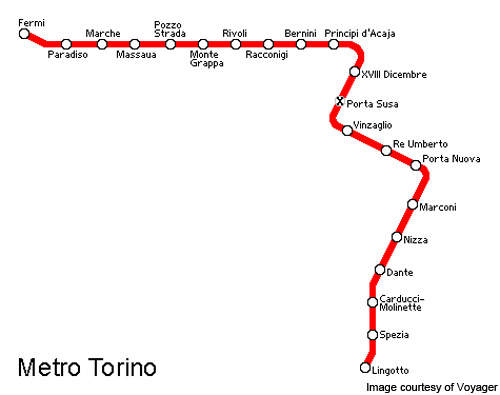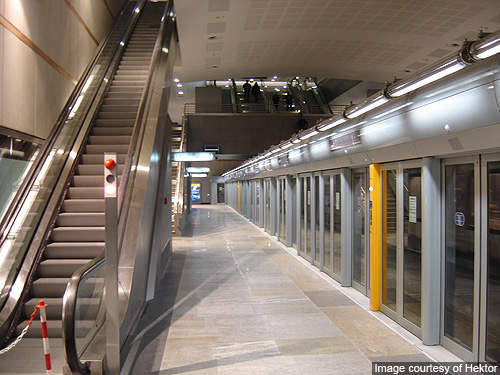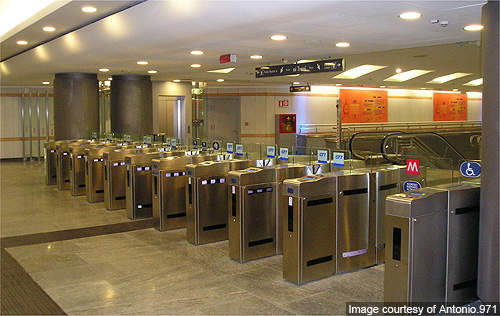Torino Metro Line 1, also known as Linea 1, is a 27.5km-long fully automated, driverless metro line based on the Véhicule Automatique Léger (VAL) system. It is being developed in four stages by the owner and operator Gruppo Torinese Trasporti (GTT).
Construction began in November 2000 with the first stage opening in February 2006 and the second stage in March 2011. Both the stages together constitute 13.2km of track starting from Fermi station in the Collegno area to the south of Turin at Lingotta station.
The total estimated cost of the two stages was €900m (Stage 1: €600m and Stage 2: €300m) funded by the State (60%), Piedmont Regional Funds (10%), Turin City Funds (24%) and GTT (6%).
The project is intended to provide transportation services to the growing metropolitan population in Turin while also improving the urban layout. The Metro Line 1 ridership is expected to increase from 22 million passengers in 2010 to 35 million in 2012 and to 40 million in 2020. Consequently the second extension will witness increase in the rise of daily ridership from 90,000 to 140,000 passengers.
Project
Stage I involved construction of a 9.5km-long underground track between Fermi station and Porta Nuova. There are a total of 15 stations on this route. The first 7.5km section from Fermi to XVIII Dicembre station was opened in February 2006 and the second 2km-long section from XVIII Dicembre to Porta Nuova station was opened in November 2007.
Stage II involved construction of 3.7km-long underground track from Porta Nuova station to Lingotto station with six stations along the line.
Infrastructure
The project features an advanced communications and video surveillance and security system supplied by Germany-based security specialist Funkwerk plettac while the associated switches were Hewlett-Packard’s (HP) ProCurve switches.
A total of 26 cameras are placed at each station including eight cameras in train, four in the rest rooms and one camera every 100m inside the tunnel. CCTV cameras are also placed at specific points at the technical maintenance site in Collegno.
The operations control centre is located at the Collegno depot. It is equipped with 28 monitors operated by an operator and a supervisor.
Of the total 21 stations, 16 stations are designed based on the basic architectural concepts of architect Bernard Kohn. The platforms have automatic edge doors equipped with flashing visual and loud acoustic signals to facilitate the use of stations by passengers with impaired vision and hearing.
The stations are also equipped with smoke detection and fire protection systems and infrared barriers to detect train position and electromagnetic detectors to avoid collision and speeding-up of trains.
The Val 208 trains will run at headway of two minutes during peak hours and will cover the entire 13.2km route in 22 minutes.
Rolling stock
Metro Line 1 is operated by a fleet of 29 Val 208 trains delivered by Siemens. GTT has ordered six more Val 208 trains to be operated on the line to facilitate the growing ridership.
Val 208 is 208m-wide and 52m-long. It is a four car train set which can be decoupled into a two car train as well. It can carry a maximum of 440 passengers in a four car train set.
It runs at a top speed of 80km/h on 750V DC current. It has rubber wheels that allow high acceleration and low vibration, thus providing passengers with high comfort and safety. Traction and electrical brakes are provided on every wheel.
Val 208 is also equipped with integrated electronic and communication systems for passengers to communicate with the rail staff at stations while on trains.
Construction
Construction of Torino Metro Line 1 involved construction of a 13km-long tunnel throughout the 13.2km track route. Four Herrenknecht earth pressure balance system tunnel boring machines were used to bore the 6.9m-7m diameter tunnel. The tunnel houses two tracks for the trains to move to and fro simultaneously.
It has a normal depth of 12m and a maximum depth of 24m to the roof. Universal ring linings made of precast reinforced concrete segments are connected to each other by 15 bib locks. Each ring weighs 23.6t and has a volume of 9.5m³.
The tunnel excavation was monitored using Geodata’s Master system.
The station sites were excavated using diaphragm walls through a hydro mill. Construction joints and concrete structure defects in all the stations were waterproofed by US-based Penetron system.
Contracts
The project management contract for Stage I was awarded to a joint venture of Systra and Geodata in 1999 and Stage II project contract was awarded to a joint venture of Systra, Geodata, Metropolitana Milanese and Studio Quaranta in 2000.
Systra is also responsible for the project design and track extension of the future 12.3km track of Stage III and IV.
The rolling stock contracts were signed in 2000 and 2008 between GTT and Transfirma GEIE Group in which Siemens SAS (France) and its Italian partner Tecnimont have a joint stake.
The signalling and control system on the line and in the control room was provided by Siemens Mobility.
Siemens and its partner Tecnimont are responsible for the service and maintenance of the automation system under a seven year contract signed in 2006. Maintenance of the communication and video surveillance systems and track equipment is shared between Siemens and its local partner.
Future
Stages III and IV are currently in planning phase. Stage III will be 1.5km track extension from Lingotto to Piazza Bengasi with two stations and Stage IV will be 12.5km extension westward from Fermi to Rosta via Cascine Vica with 10 stations.










